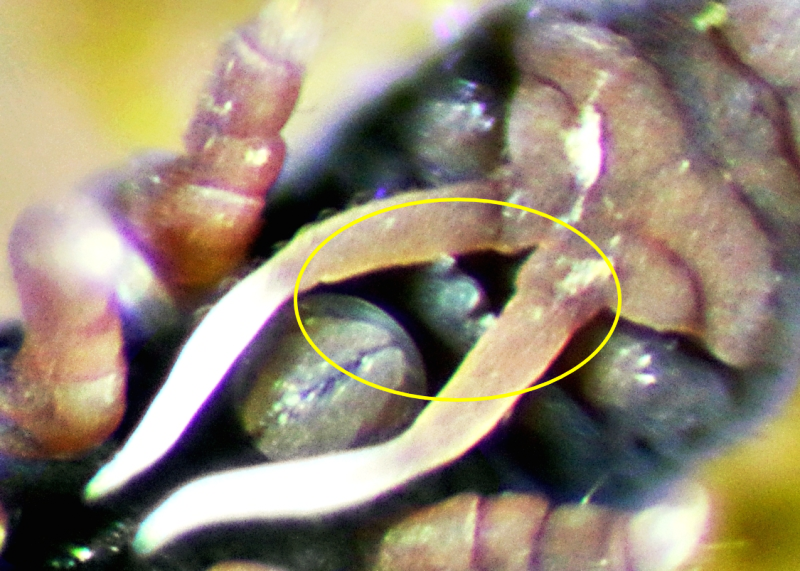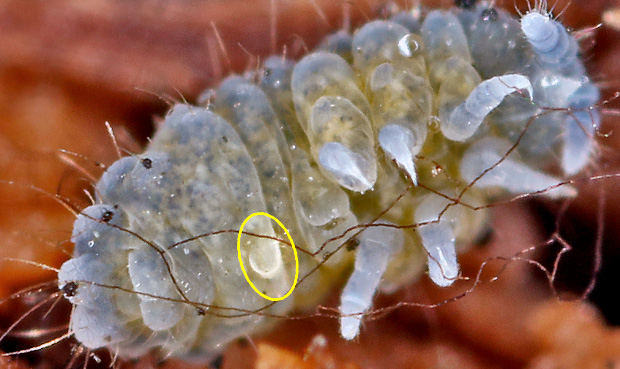This organ, which is specific to springtails, is used to make jumps to escape predators or to quickly leave the environment in which they live, for example to escape a current of water that could lead them. Although in some cases able to control the direction in which he jumps, the Springtails generally does not master all the components of his jumps and, therefore, he can not use it as an ordinary means of locomotion. However, a team of researchers [1] recently demonstrated the ability of a springtail to have some control over its jumps (see paragraph "Controlled jumps").
 The jump is a sudden muscular relaxation that causes the back of the furca, initially folded up against the abdomen and attached to the retinaculum. This very lively movement is rather a mechanism of escape that is not unlike what can be observed in certain insects such as grasshoppers.
The jump is a sudden muscular relaxation that causes the back of the furca, initially folded up against the abdomen and attached to the retinaculum. This very lively movement is rather a mechanism of escape that is not unlike what can be observed in certain insects such as grasshoppers.
In the image above1, the furca attached to the fourth abdominal segment is composed at its base of the manubrium (1) which encloses the muscular part and which is divided into two branches, each consisting of the dentes (2) each terminated by an article named mucron (3). The image in medallion comes from a video in which we see the successive positions of the springtail at the beginning of the relaxation and where we distinguish the support of the deployed furca bearing against the substrate.
The size of the furca sometimes weak, however, allows distant jumps. For example, the furca of Entomobrya dorsalis which does not exceed 2 mm long allows him to make jumps up to 16 cm. During Sminthurus viridis jumps, the acceleration peaks were measured at 970 m / s-², which corresponds to an acceleration of 98.9 g, about 10 times more than the acceleration experienced by a fighter pilot during a very tight bend!
Below we can see the decomposition of the jump2 of two species: We note that during its jump, carried back, the body of Lepidocyrtus paradoxus (Entomobryomorph, in blue) remains relatively vertical and that its head remains at the top once he left the ground while the Hypogastrura socialis (Poduromorph, in red) makes his jump forward with his head down and his body rotating on itself. During the same jumps some species can perform several tumbles which makes totally unpredictable their orientation during the landing after which they have the ability to recover very quickly.


The forms of furca and their endings vary according to the species (below, electronic microscopic photograph of the apical part of the teeth of a Symphypleone)3. It can be noted that for aquatic species, the mucron is often wider, more flattened in shape like a paddle, which allows it during jumps can be supported on the liquid without breaking the surface tension *.
* The surface tension is a physicochemical phenomenon related to the molecular interactions of a fluid, exploited by certain insects (gerrids) it allows them to move on the surface of the water without their paws getting into it.

Note: In the resting position, the furca is usually attached to the abdomen via an appendix called a retinacula that has some kind of small hooks. Himself attached to the third abdominal segment, It seems however that it is not essential for the maintenance of the furca (below example retinacs)4.We also see the folded end of the collophore)

Attached to the third segment of the abdomen, however, the retinacle does not seem essential for the maintenance of the furca (below example of retinacies)5.

It will be noted that certain species, in particular in poduromorphs, are often considered to be devoid of furca. The image below1 shows however the ventral part of a Deutonura conjuncta on which, between the collophore (on the right) and the genital plate (on the left) and one can distinguish a vestige of furca which attests that the evolution led this jumping organ to regress.
We could venture to relate this reduction to the likely evolution of the habitat of this species, leading it to frequent more and more covered places in which the function of the jump no longer has much interest in survival.

Controlled Jumps :
1: image - Dicyrtomina ornata furca - vestige of furca Deutonura conjuncta - edited by Philippe Garcelon
2: from "Le petit collembole illustré" (out of print book) - Jean-Marc Thibaud. Edition Arvernsis (2010)
3: Image - mucron and apical part of the teeth of a Symphypléone - by Jean-Marc Thibaut
4: Right images: from "ordem collembola" produced by the National School of Agronomy of Rio de Janeiro.